A. Concept & Story (written together)
Describe the concept & the story in your project.
What inspired you to create this project?
Describe your ideation process?
Why do you want to explore this topic?
Our piece explores the definition of art, and is called “What is ART?” Since we start from an abstract concept, instead of finding some narratives talking about the concrete meaning of art, we take the conceptual inspiration of a Mental Floss article answering what is art. We select some concepts from the article including the imitation and self-expression. And we also raise some concepts by ourselves. The narrative explores the properties, the forms, the expressions, and the feeling of art. The definition of art is demonstrated through questions from the conceptual, internal, and social perspectives. We want to trigger our audience to think about the question: “what is art?” Through our abstract questions and visual metaphors, we also want our audience to think about whether our project is ART.
For the visual metaphor part, although at first we want to involve more social perspectives using online footages, due to the limitation of our abtractilism aesthetic choice, we do not use obvious examples of artwork to illustrate concepts like feeling and balance. Instead, we use our own videos and use digital editing to achieve complementary effects between video and audio.
B. Creation Process & Execution (written together)
Share your storyboard and describe how it helped you in your project?
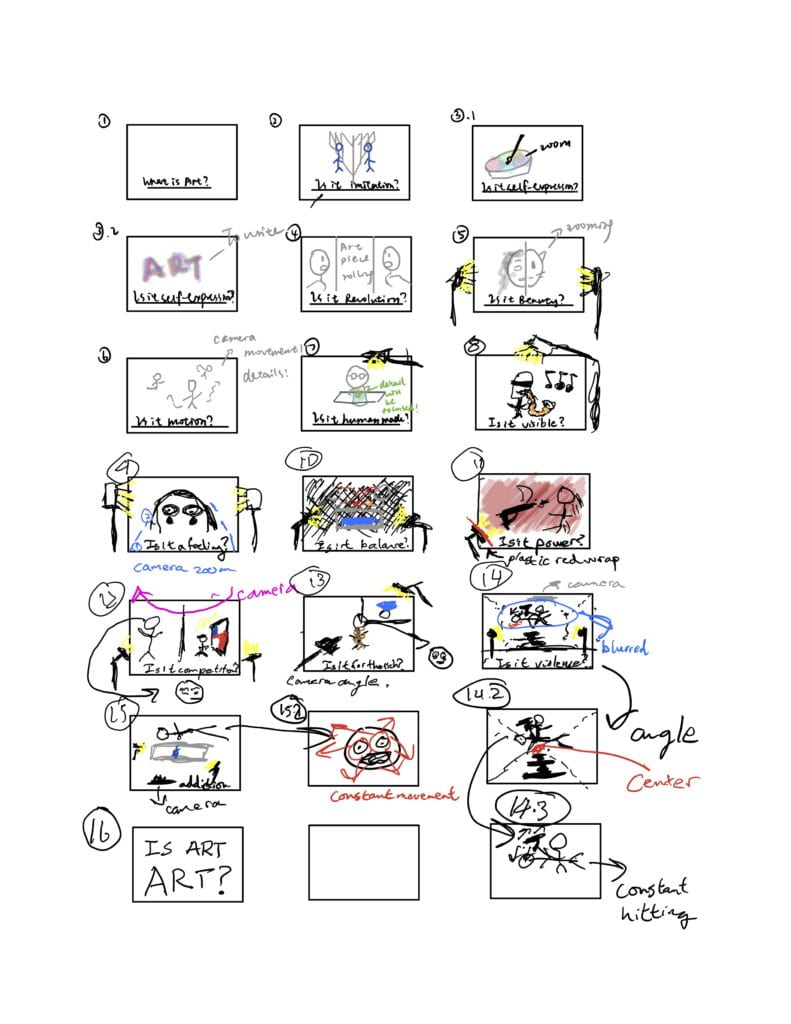
The storyboard itself reflects our initial plan, which helps us to brainstorm and adjust according to the realization difficulty and the justification of conceptual relevance. In the initial storyboard, we proposed 14 scenes with different questions, but some of them are hard to form an effective metaphor as the concept itself is so broad like beauty and revolution. Thus, we cut some scenes and only leave 9 scenes. Also, the storyboard gives us a chance to share our plan to the class, and we achieve precious feedback including Professor Inmi’s exploration of Plato and classmates’ transition consideration.
Describe the process of choosing a setting, shooting, sourcing materials, lighting, directing (if applicable).
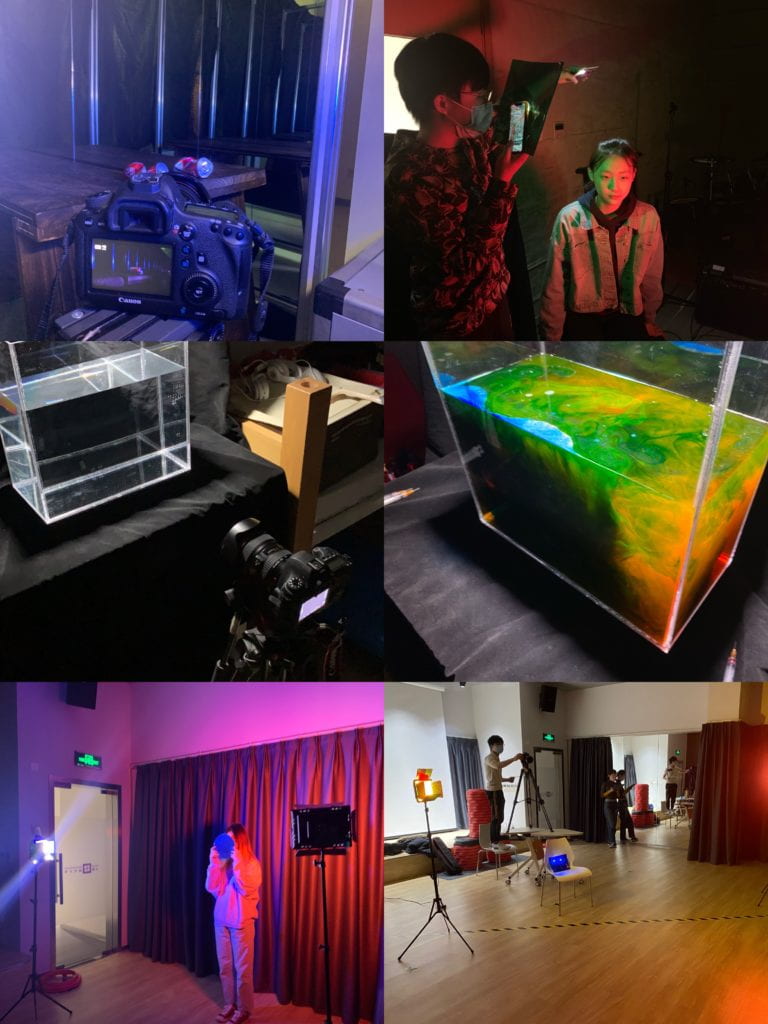
All our scenes are shot indoors. We borrowed the Canon 6D from ER. Most of the scenes are in black backgrounds, as we use the physical background, or we close the light and make lightening specifically. The ISO of the camera was carefully adjusted for the dark environment. We borrowed the lighting equipment from ER and used the color plastic filter to initially adjust the color of the video instead of relying on Pr. We use the tripods almost for all the scenes, and sometimes we even place it on the desk to achieve the camera angle we want. For example, for the scene of “is art violence?” we used an aerial perspective to attain an angle that could show both the person and the violence behind them in an interesting manner. We prepared a mirror, water vat, ink, steel ball, cola and wooden statue as props in our work. For those scenes with models, we shot several times to direct the model to the scene and emotion we wanted to be expressed. We also tried different color combinations. The most time consuming scene is the ink balance in the water. We shot twice, which took nearly 2 hours.
Describe the challenges you encountered during the content creation process, and how you solved or overcame them.
For the audio part, at first our shotgun seemed to have some problems due to the connection wire being incorrectly provided by the ER, so we used the internal mic at first but realized that the noise of human sound and ambience was so obvious that we borrowed the shotgun again and recorded it twice. The dark environment makes the lighting important. While Coco tried to find the suitable camera angles and direct the model to the state, Ken tried hard to move around the space to find the right position of light. Such a setting was not proposed in our storyboard, as firstly we only wanted to use the fixed lighting. Moreover, as some shots needed variation of lighting to create a disappearing effect, Ken would move the lighting accordingly to create the intended effect. In addition, as our work is conceptual, to achieve agreement, we brainstorm several times until we finish shooting all the scenes. We read some articles regarding Plato’s imitation, and adjusted the imitation part into still versus movement to achieve the sense of imitation of the real world. The feeling part is also difficult, as we started from the emotional feeling, but we agreed on the physical feeling in the end.
Describe your editing & Post-Production process, you may share a few of screenshots from Premiere about the editing techniques and effects you learned.
For the audio part, we add the convolution reverb and echo for the ending part to create a sense of confusion and chaos. And we apply the noise reduction technique for the whole piece.
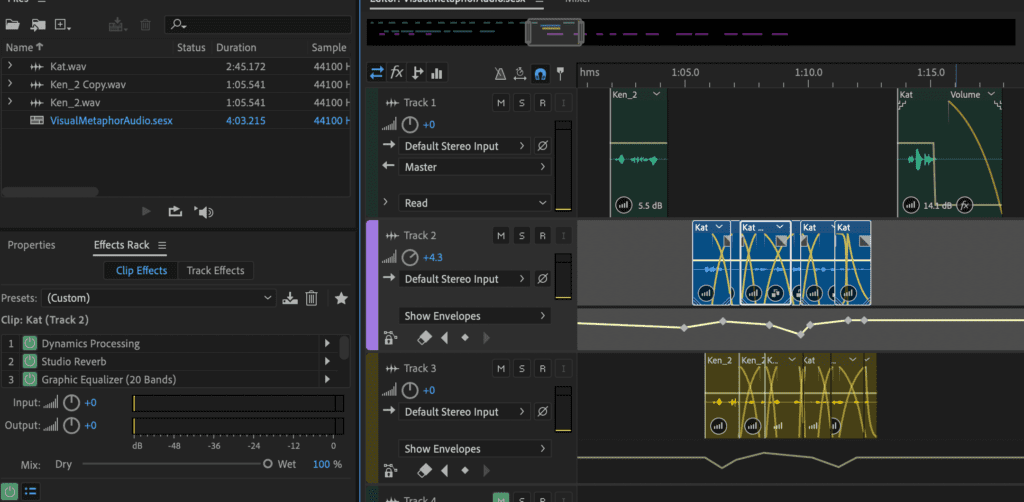
For the video part, we do a lot color corrections to reduce the incoherence of different scenes. We apply the threshold effect to create the black and white cartoon effect for the beginning and ending.
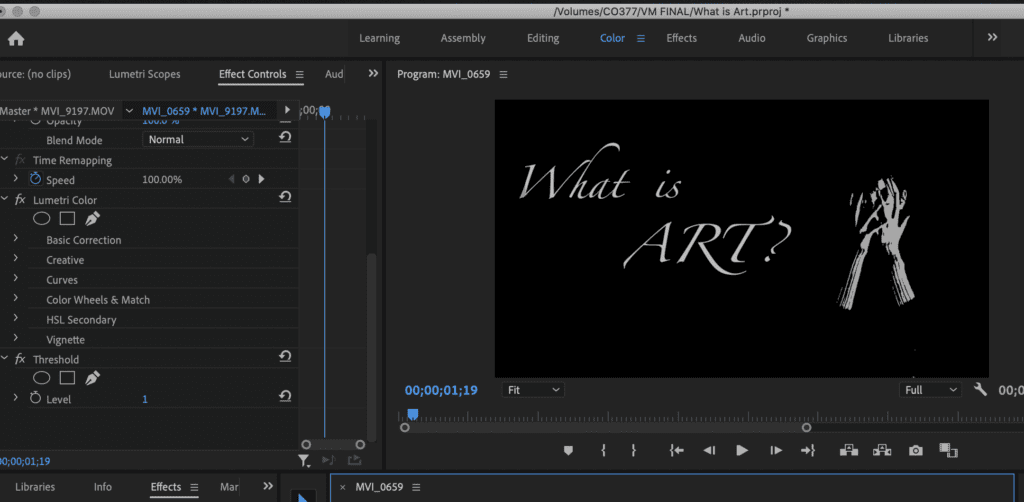
We use the turbulent displace effect to make the straight lines into circular ones to make the scene unreal.
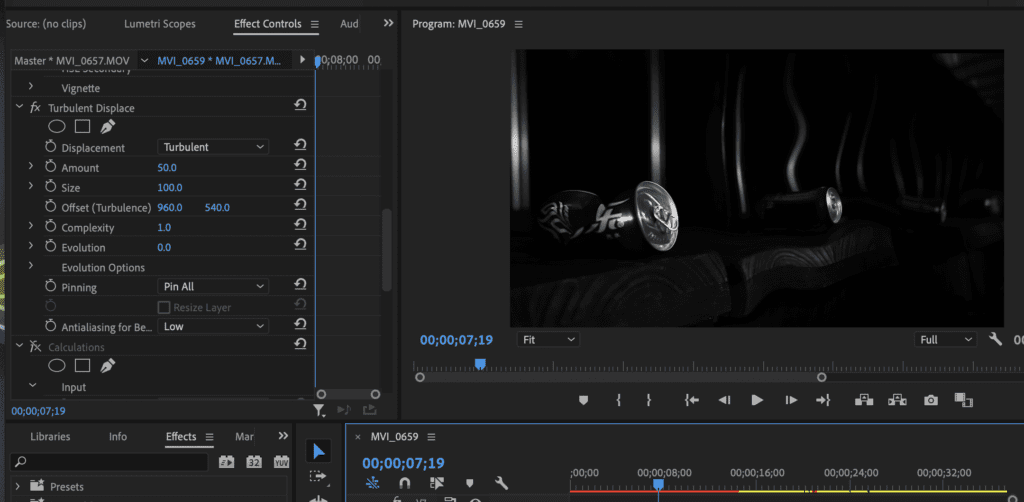
The tint effect is applied to the visible part to create the color transition between different eyes.
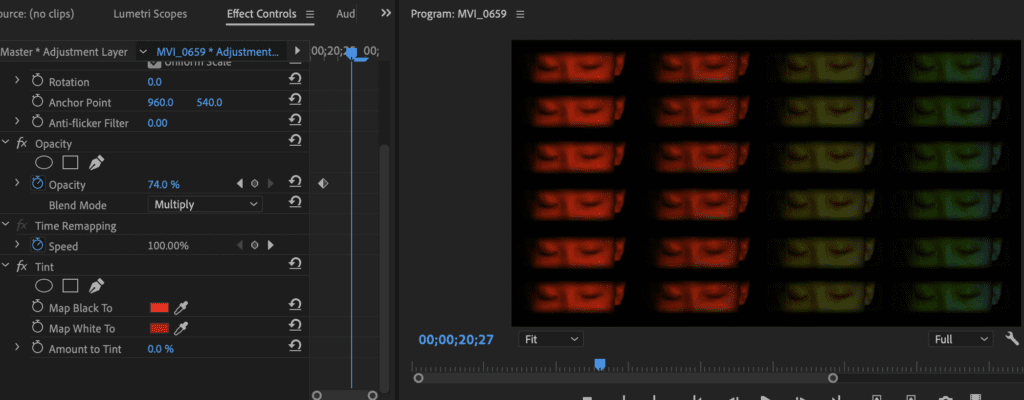
The transition part is to use the clock for scale transition.
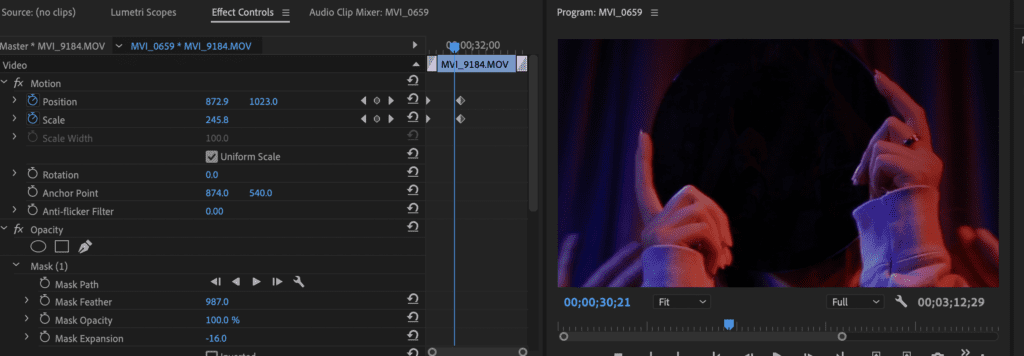
Also, we cut the video into small pieces to create the flashing effect we want.

We also overlap many pieces to create the looming layer effect of the “feeling” part.
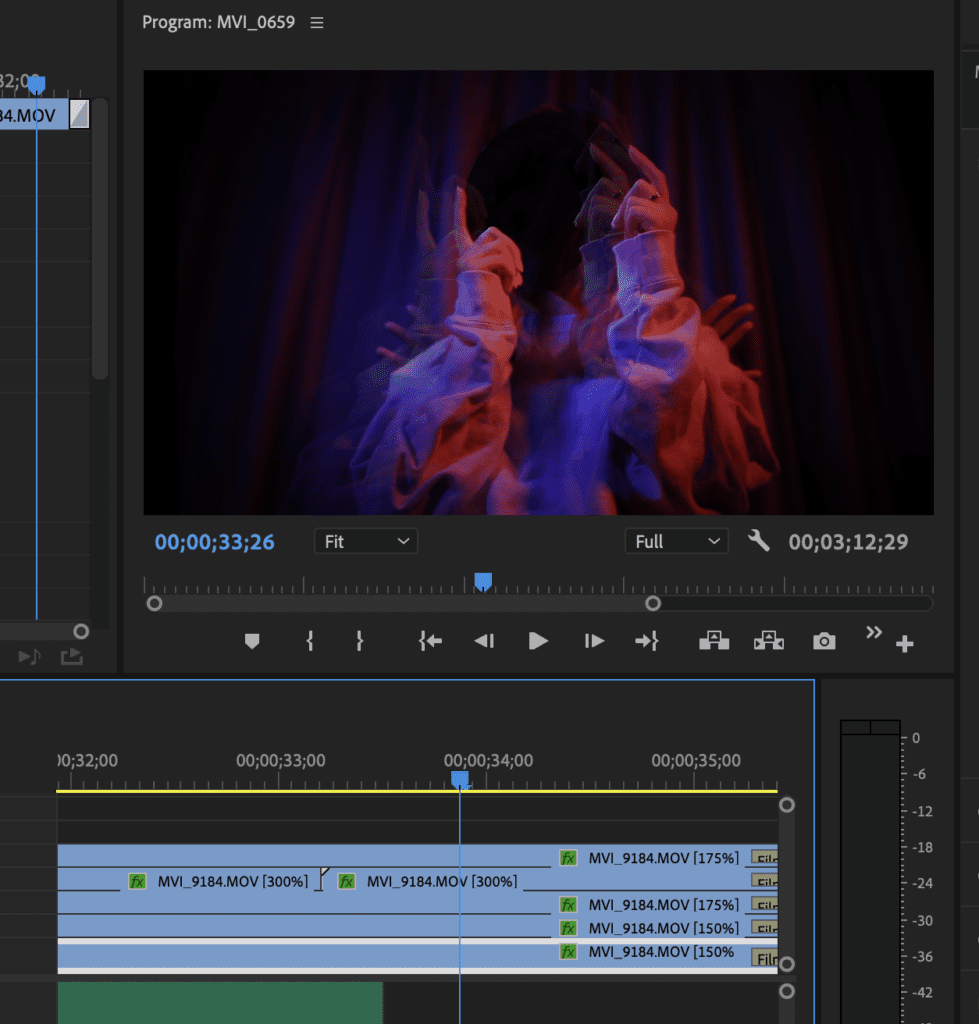
For the drug part, we use the “find edges” to present the edges of the model into black and white, making it coherent with the ending part.
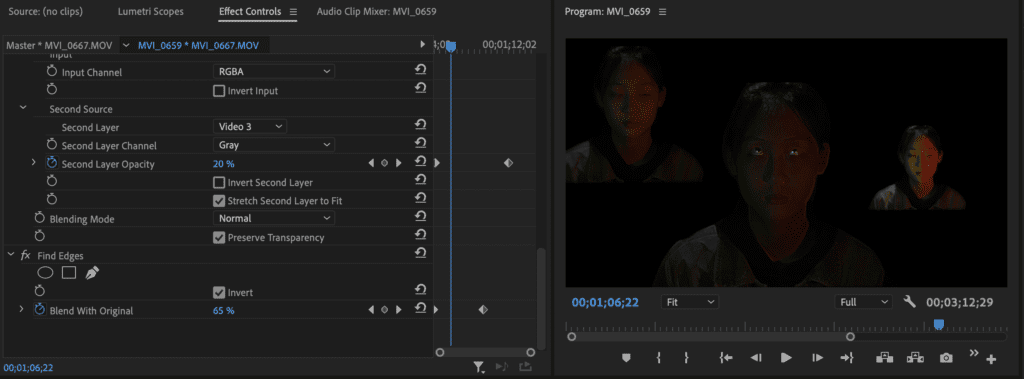
Masks are frequently used as we have the black background, making the editing process easier. 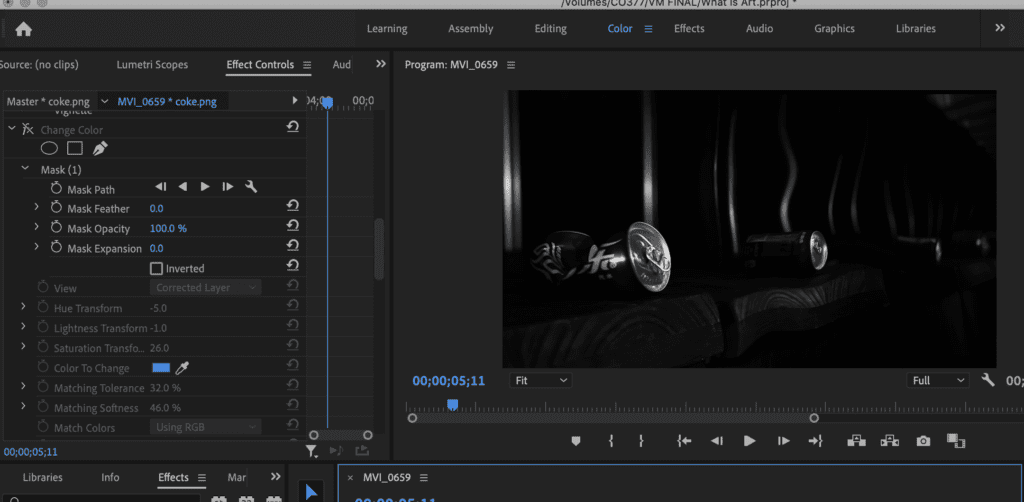
C. Collaboration (written by self)
Describe your own role in and contribution to the project. Express appreciation for the work your teammate did. How did the collaborative process and exchange with your partner inform your project? Was there something you learned from your partner?
Personally, I think that my role in the project was much more focused on ideation and creation. I would focus on contributing concepts to Coco where our ideas would integrate in an expressive manner. As we would ideate together, I would have an understanding of what Coco thought ideas could be represented in and I would consider the camera angles that this could be taken in including the color and what not. During the video sessions, we would divide our work evenly where I would manage the lighting while Coco would manage the camera. We wouldn’t solely do our task without reviewing video drafts taken for color and camera angle and collaborated to make the color and camera angles more expressive for our intended result.
Amidst all our finals and other projects, Coco sacrificed her time to edit the rough cut, audio, and the scenes for critique days before the final which was crucial for us to attain feedback on what needed to change and why. It was because of her sacrifice of time and effort that I was able to make time to edit the final version by finishing all other assignments I had to make every scene cleaner, more expressive, and artistic according to the vision we thought out together. Of course, having a rough cut with all the files already labeled eased my final editing process by a lot as I could refer to her scenes and make changes to color, effect, and etc. This allowed me to create the darker aesthetics that correspond with the uncertainty of defining art. I would pull an all-nighter on Wednesday to Thursday right before class to complete the final cut of the visual metaphor video by experimenting with different ways of expressing the visuals for the concepts we had of art.
I appreciate the effort Coco put in all throughout the group project, especially with her leniency on aesthetics as my style differs very much from her style. It is this difference that truly informed me a new way of editing to convey our concept of what is art. More explicitly, her creative process and style of creating the rough draft was also something I learned from her. Her usage of repetition of the same object or person doing the same action helped create a sort of dynamic nature within the piece that I would have never incorporated as my style is lackluster of repetition and more focused on single shots. Having worked with her, I’ve realized how repetition could be used within a shot to create movement and fluidity rather than the static nature that my videos may show.
D. Aesthetics & Results (written together)
From camera language (using long-shot, different camera angles) to color correction/adjustment to establishing the tone of video, please describe how the aesthetics you choose to pursue supports your concept and story, and do you think it is effective? You may also share your inspirations and references which are relevant to this aesthetic.
For the video, we choose to pursue the abstractism style through using various visual metaphors. Aesthetic-wise, most scenes use the still camera mounting, and tried different camera angles through different settings. The transition part with the scale change is all done by the digital editing process. The dark color tone we choose for this project is totally corresponding to the aesthetics we want, as we can easily use the masks to cut the model movement out and add some fancy effects. We also lower our aperture to create a gloomy mood and presentation as darker portrayal is normally associated with the lack of information or uncertainty which also corresponds to the objectivity of defining art.
Leave a Reply